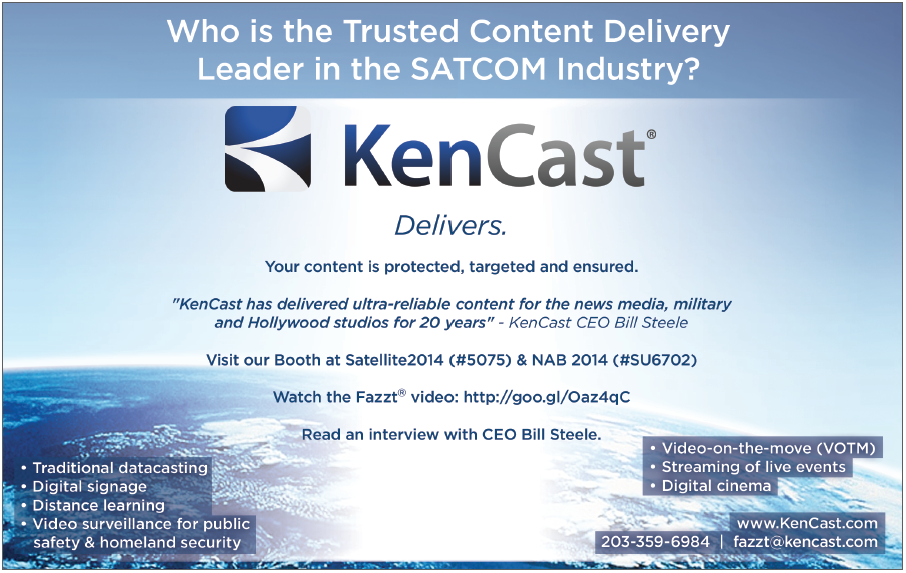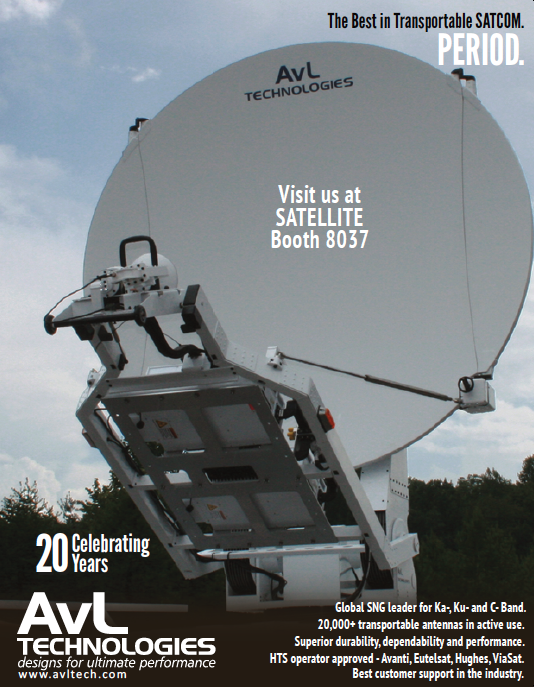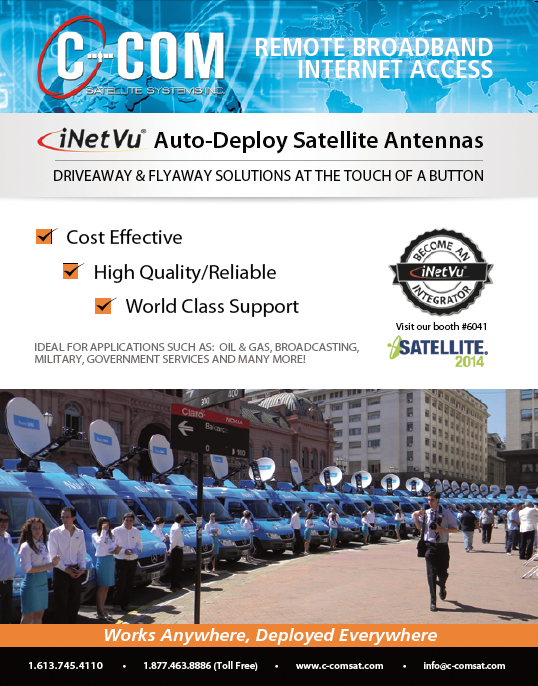Dr. William E. Steele is the Chairman & CEO of KenCast, Inc. Prior to starting KenCast, Dr. Steele worked for GTE for 14 years, spending the last five as General Manager of the GTE ImageSpan division of GTE Spacenet.
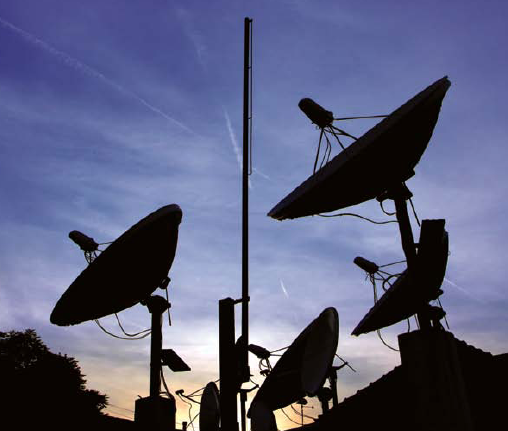
Dr. Steele’s other positions in the satellite and telecommunications industry include Vice President of Marketing at the Microband subsidiary of McDonnell-Douglas and Sales Manager at the American Satellite Corporation division of Fairchild. Dr. Steele was an Assistant Professor of Economics at Villanova University and holds a Ph.D. in Economics from New York University.
SatMagazine (SM)
Why did you initially become involved in satellite communications and the satellite broadcasting industry? Moving from an Assistant Professor of Economics and to McDonnell-Douglas seems to be a rather profound step from an educational environment into a marketing oriented position?
Dr. Steele
My entry into satellite communications was a doctoral thesis on the benefits of the SEASAT satellite for NASA and the U.S. Maritime Commission. This dealt with ocean routing, fishing fleet support, and similar tasks. My dissertation discussed international trade patterns and identified cargo types and ships on various sea routes.
I was then hired as an economist by Mathematica, a consulting company owned by Princeton University professors, to do cost-benefit studies for NASA. There were two purposes to these studies. We evaluated the candidate’s scientific instruments that could be put on the various satellites, estimated the societal and economic benefits, and recommended the optimal instrument payload. Secondly, the financial benefits we identified directed and supported NASA’s request for funding from Congress for their various satellite project candidates. In the course of this work, I saw that communications satellites were a major opportunity and subsequently managed my career in that direction.
SM
You were an executive with the satellite business division at GTE and the firm’s related holdings, the predecessors to Verizon, before founding KenCast. What were some experiences and ideas from your time at GTE that inspired you to launch a software company?
Dr. Steele
I was the General Manager during my last 5 years at GTE—actually, GTE ImageSpan, whose mission was to take advantage of satellites that could deliver live video and files to computers. GTE sold their satellite fleet in 1993 to General Electric, which decided not continue the work of GTE ImageSpan. The potential resident within satellites was quite apparent to me, so I subsequently founded KenCast and pursued this market.
SM
Moving from a corporate technology giant to a startup must have been quite a change and a challenge. Were there any “take aways” that helped you to build KenCast?
Dr. Steele
My early experience with NASA’s and Fairchild’s and GTE’s satellite programs gave me an early appreciation of the potential of the first digital satellites for communications applications in which content was multicast to computers at large numbers of remote sites. We also quickly gained an appreciation for, and solutions for, the requirements to deal with security, reliability, and efficiency. These are complex problems and require a high degree of skill to solve. Our solutions were in many cases unique and patentable. This gave us a strong position early in these emerging markets..
I wanted to solve the problems facing SATCOM that would unlock the technology’s full potential. I recognized the need for content delivery and management software. One of the major problems satellite communications faces is the reliable delivery of secure (encrypted) content. Satellite communications is inherently more “noisy” than terrestrial networks, such as fiber optics. When sending encrypted content, loss of even a few bits can render content useless—it cannot be decrypted. Highly reliable content delivery and innovative error correction algorithms are extremely useful to satellite delivery and is a technology KenCast continually works to improve.
SM
Speaking of hiring the best talent, how can we, as industry, entice today’s students into STEM (Science Technology, Education, and Math) study and the subsequent enjoyment of a fulfilling SATCOM career? How can the industry otherwise ensure a highly viable professional pool of candidates for hiring now and in the future?
Dr. Steele
KenCast generally hires staff right out of school, which has been a source of fresh thinking and innovation for the company. We have been doing this for 20 years. As an example, our President, Lewis Wolfgang, was hired in the summer of 1997 when he graduated with a Ph.D. out of MIT. I think the satellite industry would do well to consider hiring, training, and patiently growing the skill sets of talented young people. They are astute, learn and become productive quickly.
SM
Were there any surprises in the early days? Didn’t an early partner, Dr. Fischer from Yale, help to identify and resolve a particular relevant issue?
Dr. Steele
Yes—even though I knew SATCOM needed content delivery software support, I believed I would be prioritizing on the security aspects. I recruited Professor Fischer, a cryptographic expert, to help resolve this issue. It turned out that he was able to highlight, early on, an even higher priority—reliability. Once identified, work on our patented forward error correction technology commenced immediately.

SM
Interference plays havoc with content conveyance. How does KenCast advise its clients in regard to this issue? What steps has KenCast taken to mitigate RF obstruction?
Dr. Steele
We provide a variety of applicable tools to deal with error correction for file recovery and for cleaning up live streams that have been damaged during transmission. In addition, it is important for satellite application owners to be aware of the trade offs available with respect to dish size, error correction overhead, broadcast power, quality of transmission and receive equipment, as well as the use of software (multiplexing, retransmission, missed packet collection, etc.). This must be followed up with solid expert advice in order to achieve the balance between cost and performance.
SM
There are a number of content delivery networks on the market today, with more under development throughout the industry. All claim to have the ability to deliver mammoth blocks of data, securely and with high reliability. What makes KenCast’s Fazzt™ Digital Delivery System different and how does this product play its role in the streaming of satellite content?
Dr. Steele
There are many good CDN companies in this market. Reliable content delivery is constantly growing, evolving, and generating new requirements. Such demands require new solutions, which must be uncovered all the time. Companies that identify their emerging demands and bring solutions to market early, if not first, have the best chance to succeed while others fall by the wayside. KenCast has a solid track record here. Having the large customer base we now serve often means recognition of the fact that when two or more of customers want the same new feature or service, it is evident that the particular technology being requested must get to the market as quickly as possible—and before the competition.
SM
A growing market segment for satellite broadcasting revolves around digital cinema, as well as the relay of live events to screens. May we have your thoughts on the satellite’s role in this arena and why acceptance seems to be somewhat slower in North America for digital cinema, as opposed to Europe where the number of digital screens continues to rise
Dr. Steele
The major exhibitors (AMC, Regal, and Cinemark) are 100 percent digital in the USA. The critical mass to move from hard disk delivery of movies to the early digital theaters, to satellite, was reached last year (2013).
The US market, spearheaded by the 3 major exhibitors and the 7 major studios (Warner Bros, NBC Universal, Disney, Lionsgate, Sony Pictures, Paramount, and Fox) through the DCDC (Digital Cinema Distribution Coalition) are now using satellite to delivery first run movies in the USA. Europe does not have a single entity like DCDC to lead the move to satellite delivery. There are currently several competing efforts underway to bring satellite delivery to the digital theaters in Europe.
SM
What type of satellite application are you involved in that uses bonding of multiple satellite transponders?
Dr. Steele
For digital cinema, in the DCDC (Digital Cinema Distribution Coalition) system of delivering movies to theaters, we can use two transponders with bonding for speed (at 144Mbps) and redundancy. We also have forward error correcting and validation technology in our content delivery software servers and clients that can reconstruct the content should any data corruption occur. The validation is so accurate that the chance of it being incorrect on zero-error certification is roughly equal to the chance of winning the Lottery 1,200 days in a row.
SM
Do studios deliver, via the DCDC, their movies exclusively by satellite?
Dr. Steele
Not entirely. We are also multicasting to a small percentage of theaters using fiber optic-based MPLS networks. The ability to multicast on satellite and multicast/unicast on fiber gives us the flexibility to deal with various situations, such as when we cannot get rooftop rights or satellite line of sight for the theater.
SM
What role can satellite broadcasting play, or currently plays, within the growing digital signage industry?
Dr. Steele
Use of satellites for digital signage is extensive as it is a method to deliver large files (video content typically) to hundreds/thousands of remote sites via a single satellite multicast. Interoperation of cloud-based facilities and satellite delivery will enable highly scalable, very-efficient, shared-resource signage applications. Many signage companies are exploring this avenue now.
SM
What other areas or applications involving satellite communications is KenCast involved in?
Dr. Steele
Via satellite, those would include Digital Cinema, Learning, Signage, VOTM (Video On The Move), global weather alerts, a significant number of large military systems for the US military and allies, and other systems.
SM
How can you keep up with all those markets?
Dr. Steele
Often we work with partners for a total solution, such as satellite uplink providers, signage and learning software companies, as well as consortiums such as the DCDC and even the federal government.
SM
As the CEO of a digital data delivery systems company with a large footprint among satellite users that spans multiple industries, and with two decades of experience supporting you, do you have any predictions or observations of trends for the future of satellite communications?
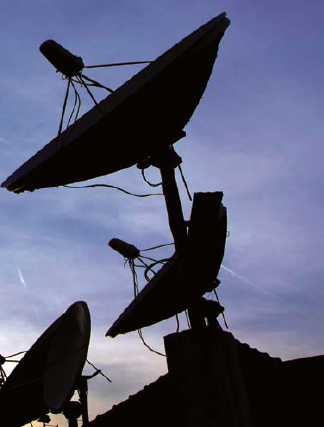
Dr. Steele
Enterprises are becoming more familiar with their networking options, including satellite and fiber and the Internet, both wired and wireless. Fiber networks are continuing to extend coverage and the Internet is getting faster. This means there will likely be more hybrid networks in which content will be delivered more optimally—large files and streams targeted to many locations will be multicast by satellite or MPLS fiber, large files going to a few sites will be sent UDP with acceleration on the Internet, and so on. More users, from sophisticated enterprises to individuals in developing countries (helped by new networks such as Google’s Other 2 Billion constellation—O3B) will be appearing on all IP networks. This will drive investment in all IP networks, driving coverage footprints, available bandwidth, and devices.
SM
What is your favorite project/customer and how does it highlight the value delivered by satellite communications and your technology?
Dr. Steele
The DCDC (Digital Cinema Distribution Coalition) project to deliver movies for studios to thousands of theaters globally is one of my favorites. Everyone loves the movies, and this implementation put in place more efficient distribution, better security, and higher quality at lower cost. The Studios, Exhibitors, and Viewers all win.
We worked on a variety of projects and relationships in digital cinema for many years before selection for this project. Transmission via multicasting is economical for frequent communication of big data to large target audiences, and satellites will continue to provide great economics and performance for it.
SM
When you look back over your career, what project or projects truly brings a smile to your face, a smile of satisfaction.
Dr. Steele
News is time sensitive. Reliable delivery of news was ripe for a satellite solution in the late nineties. The Associated Press, with 4,500 newspapers, and the TV news agencies (ABC, CBS, NBC, CNN, internationally agencies such as Cihan in Turkey and Kyoto in Japan) and other entities were all looking for reliable service on the new digital satellite networks. KenCast’s highly reliable content delivery met the emerging requirements for these customers—this enabled KenCast to successfully launch a growing and dynamic business.
For additional information regarding KenCast, please visit http://www.kencast.com/
For an informative video regarding KenCast’s Fazzt offering, please access http://youtu.be/U0RvH3vs0Yo


